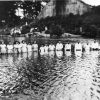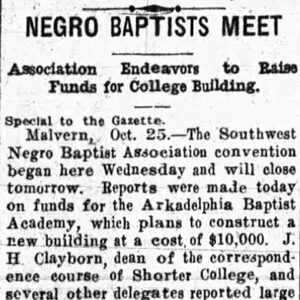calsfoundation@cals.org
Arkadelphia Baptist Academy
The Arkadelphia Baptist Academy in Arkadelphia (Clark County) was one of many schools founded across the South by the American Baptist Home Mission Society, which was headquartered in New York. Beginning in 1865, the northern Baptists joined other denominations in the effort to educate the recently freed slaves across the South. In an article published in the New York Times in 1897, the society’s corresponding secretary, General Thomas J. Morgan, noted that, after the war, “the problem presented itself of the intellectual elevation of 4,000,000 human beings, just emerging from a degrading bondage.” During the thirty-two-year period between the end of the war and Morgan’s statements, the Home Mission Society had spent about $3 million, and its more than thirty institutions were providing education for more than 5,000 students, from primary school to colleges and universities.
The Arkadelphia Baptist Academy, located at 18th and Caddo streets, was organized as Arkansas Industrial College by F. L. Jones on August 15, 1890. In 1892, the college’s name was changed to Arkadelphia Academy, and it became associated with Arkansas Baptist College in Little Rock (Pulaski County). The academy was originally founded to train workers for church work, and the Bible was the foundation of all coursework. In 1892, Jones was being assisted by Amanda Talley and Lizzie Watts, and the enrollment was ninety-two. The following year, there were twenty-six male and sixty female students, fifteen of whom were boarders. The average daily attendance was fifty-seven. The Home Mission Society was providing $500 toward the teachers’ salaries, while the “colored people” were providing $790. There were no industrial courses being taught, but twenty-six students were preparing to teach and three were preparing for the ministry. In 1894, the academy’s property was valued at $2,700.
The academy apparently faltered during the next several years, however, as enrollment dropped to fifty by 1899. By 1905, this number had dropped to twenty-six, all but two of whom were female. That year, Samuel P. Nelson, a graduate of Butler College and the University of Chicago, took over leadership of the academy. He remained until 1919. Enrollment rose to eighty by 1913.
Thomas Jesse Jones visited the academy for the Department of the Interior in 1914 and 1915. He described it as “an elementary school with some pupils in secondary subjects.” It was owned by the local Baptist association, and the board of trustees was composed of members of the association. Enrollment was ninety-five, eighty-five of whom were in the elementary school. Jones noted that “because of inadequate support, the work is ineffective….Some instruction in sewing is provided….The garden is cultivated, but without regard for educational values.” The staff consisted of four African-American teachers, three of whom were female. The plant was valued at $3,200 and consisted of ten acres of land, a frame building in need of repair, and meager equipment. Jones recommended that the school be moved to “some section of the State where it is more needed, or combined with one of the larger Baptist schools.”
There are very few records on the Arkadelphia Baptist Academy after this time. It was still in existence in 1929, when the Daily Tribune and Evening Times of Ames, Iowa, reported that the academy’s football team had defeated the black team from Conway High School by a score of 156–0. In September 1930, the academy’s main building was destroyed when fire broke out in one of the upper stories. The academy may have still existed in some form in 1940, when it was enumerated in a separate census district in Caddo Township.
For additional information:
“$40,000 Damage Caused by Fire at Arkadelphia.” Hope (Arkansas) Star, September 24, 1930, p. 1.
Jones, Thomas Jesse. Negro Education: A Study of the Private and Higher Schools for Colored People in the United States. Washington DC: Government Printing Office, 1917.
“Negro Team Scores 156 Points in Game.” Ames (Iowa) Daily Tribune and Evening Times, November 13, 1929, p. 6.
“Negroes of the South: American Baptist Home Mission Society and its Efforts for their General Education.” New York Times, April 11, 1897, p. 16.
Richings, G. F. Evidences of Progress Amongst Colored People. Philadelphia: Geo. S. Ferguson Co., 1902. Online at http://docsouth.unc.edu/church/richings/richings.html (accessed October 26, 2021).
“Secondary Schools for Colored People: Arkadelphia Academy.” Baptist Home Mission Monthly 17 (August 1895): 297.
Sixty-Third Annual Report of the American Baptist Home Mission Society. New York: American Baptist Home Mission Society, 1895.
Work, Monroe Nathan. Negro Yearbook and Annual Encyclopedia of the Negro. Tuskegee, AL: Negro Year Book Publishing Company, 1913.
Nancy Snell Griffith
Clinton, South Carolina
 Religion
Religion Baptist Academy Article
Baptist Academy Article 



Comments
No comments on this entry yet.